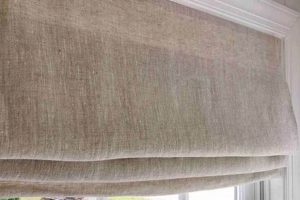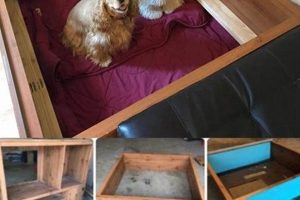A do-it-yourself human waste management system, suitable for short-term rentals hosted on platforms such as Hipcamp, employs natural decomposition processes to transform excrement and organic matter into a usable soil amendment. These systems typically involve a container to collect waste, a bulking agent such as sawdust or peat moss to aid decomposition and odor control, and a method for managing liquids. This approach to sanitation offers an alternative to traditional septic systems or outhouses, particularly in locations where water is scarce or conventional plumbing is unavailable.
The implementation of such a system at Hipcamp locations offers several advantages, including reduced water consumption, decreased reliance on complex infrastructure, and a smaller environmental footprint. Historically, composting toilets have been utilized in off-grid living situations and areas with limited resources. Their resurgence in popularity reflects a growing interest in sustainable practices and responsible land management. Benefits also include the potential for producing valuable compost that can enrich soil and reduce the need for synthetic fertilizers.
The subsequent sections will delve into the practical aspects of constructing and maintaining these systems, outlining various designs, material considerations, and best practices for ensuring safe and effective operation. Furthermore, relevant regulations and guidelines pertaining to their use on hosting platforms will be examined, along with strategies for educating users on proper usage and maintenance.
DIY Composting Toilet Tips for Hipcamp Hosts
Effective construction and maintenance are critical to the successful implementation of a DIY composting toilet on a Hipcamp property. Adherence to the following guidelines will contribute to a safe, sanitary, and environmentally sound waste management solution.
Tip 1: Ventilation is Paramount: Ensure adequate airflow within the composting chamber. Insufficient ventilation leads to anaerobic decomposition, resulting in unpleasant odors. A properly sized vent pipe extending above the roofline is essential. Consider incorporating a small fan, powered by solar energy, to enhance airflow.
Tip 2: Carbon-Rich Bulking Agent: Utilize a dry, carbon-rich bulking agent such as sawdust, peat moss, or shredded leaves after each use. This absorbs excess moisture, promotes aerobic decomposition, and mitigates odors. The ratio of bulking agent to waste should be carefully monitored and adjusted as needed.
Tip 3: Regular Turning or Mixing: To facilitate decomposition, the compost pile requires regular turning or mixing. This ensures even distribution of moisture and oxygen throughout the pile. A long-handled tool, dedicated solely for this purpose, is recommended to minimize contact with the composted material.
Tip 4: Liquid Management: Separate urine from solid waste whenever possible. Urine is high in nitrogen and can contribute to anaerobic conditions if not managed properly. Diverting urine into a separate container and using it, diluted, as a fertilizer can be beneficial.
Tip 5: Temperature Monitoring: While not always essential for basic DIY systems, monitoring the temperature of the compost pile can provide valuable insights into the decomposition process. Ideal temperatures for thermophilic composting range between 130F and 160F (54C and 71C).
Tip 6: Proper Sealing: Ensure the composting chamber is sealed adequately to prevent the entry of pests, such as flies and rodents. Utilize screens and tight-fitting lids to maintain a hygienic environment.
Tip 7: Waste Disposal Considerations: Once the composting process is complete, the resulting material must be disposed of responsibly. Consult local regulations regarding the safe disposal or application of composted human waste.
By implementing these tips, Hipcamp hosts can provide a more sustainable and environmentally friendly sanitation option for their guests, minimizing their impact on the surrounding ecosystem.
The next step involves a discussion of the legal and regulatory considerations pertaining to the use of these systems on commercial properties.
1. Design Suitability
Design suitability, with respect to a do-it-yourself composting toilet system employed on a Hipcamp property, directly impacts its overall performance and acceptance by users. Inadequate design considerations can lead to operational deficiencies, including insufficient decomposition, odor generation, and structural instability, thereby negating the intended benefits of the system. A well-suited design, conversely, optimizes decomposition processes, minimizes environmental impact, and enhances user comfort. For instance, a high-traffic Hipcamp site necessitates a larger capacity composting chamber and a more robust ventilation system than a low-usage site. Failure to account for these differences can result in system overload and operational failures.
Practical applications of design suitability extend to material choices and accessibility features. Selecting weather-resistant materials such as rot-resistant wood or durable plastics minimizes maintenance requirements and extends the lifespan of the system. Incorporating universal design principles, such as a wider doorway and appropriate seat height, ensures accessibility for individuals with mobility limitations. The choice of composting method, whether batch or continuous, should align with the frequency of use and the host’s maintenance capabilities. Continuous systems, while more complex, can accommodate higher volumes of waste but require more frequent monitoring and maintenance. Batch systems, simpler to manage, are better suited for lower-usage scenarios.
In conclusion, design suitability is a critical determinant of the success or failure of a DIY composting toilet system on a Hipcamp property. The integration of site-specific factors, user needs, and environmental considerations into the design process is paramount. Challenges arise when generic designs are implemented without appropriate customization. Addressing these challenges through careful planning and a focus on design principles can lead to a sustainable and effective waste management solution that enhances the Hipcamp experience while minimizing environmental impact. The selection of an appropriate and meticulously planned design will inevitably enhance guest experience and foster responsible waste disposal practices.
2. Material Selection
Material selection constitutes a foundational aspect of constructing a do-it-yourself composting toilet for use on Hipcamp properties. The chosen materials directly influence the system’s durability, functionality, environmental impact, and overall cost-effectiveness. Thoughtful consideration of material properties and sourcing is, therefore, paramount to a successful and sustainable implementation.
- Composting Chamber Construction
The composting chamber necessitates materials resistant to moisture, decomposition, and physical stress. Options include rot-resistant wood species (e.g., cedar, redwood), durable plastics (e.g., HDPE, polypropylene), or concrete. The choice depends on budget, desired lifespan, and aesthetic preferences. For instance, using untreated lumber can lead to premature failure due to decay, while using recycled plastics can contribute to environmental sustainability.
- Containment and Liners
Inner containers or liners, often made of plastic, serve to contain waste and facilitate cleaning. These materials should be non-reactive, preventing chemical leaching into the compost. Food-grade plastics are generally recommended to minimize potential contamination. The use of biodegradable liners, while seemingly environmentally friendly, may decompose prematurely, requiring more frequent replacement.
- Plumbing and Ventilation Components
Piping for urine diversion or ventilation requires materials resistant to corrosion and degradation. PVC or ABS pipes are commonly used, offering durability and ease of installation. Selecting pipes with adequate diameter ensures proper airflow and prevents clogs. Copper piping, while durable, is generally cost-prohibitive for most DIY projects and may react with the composting environment.
- Bulking Agent Considerations
While not a direct component of the toilet structure, the bulking agenttypically sawdust, peat moss, or coconut coirplays a crucial role in the composting process. The material should be readily available, absorbent, and carbon-rich. Using sustainably sourced bulking agents minimizes environmental impact. For example, opting for locally sourced sawdust from a responsible lumber mill can reduce transportation costs and promote regional resource utilization.
The relationship between material selection and the successful operation of a do-it-yourself composting toilet for Hipcamp is undeniable. Prioritizing durability, sustainability, and compatibility with the composting process ensures a long-lasting, environmentally responsible, and user-friendly waste management solution. Overlooking these material considerations can lead to premature system failure, increased maintenance, and potential environmental harm, undermining the benefits of implementing such a system in the first place.
3. Maintenance Protocols
Maintenance protocols are intrinsically linked to the successful operation of a do-it-yourself composting toilet system within a Hipcamp setting. The absence of clearly defined and consistently implemented maintenance procedures directly contributes to system malfunction, odor problems, and potential health risks, effectively negating the environmental and sanitation benefits these systems are intended to provide. Conversely, diligent adherence to well-structured maintenance schedules ensures optimal performance, prolongs the lifespan of the system, and fosters positive user experiences, contributing to the overall success of a Hipcamp host’s sustainable practices.
Specific examples illustrate this cause-and-effect relationship. Insufficient addition of bulking agents, a critical maintenance task, leads to anaerobic conditions and the generation of unpleasant odors, deterring users and potentially creating a sanitation hazard. Similarly, infrequent emptying of the solids or liquids collection chambers results in overflow, posing hygiene risks and requiring extensive remediation. A well-defined maintenance protocol addresses these potential issues through scheduled bulking agent replenishment, regular chamber emptying, and periodic inspection of ventilation systems to ensure adequate airflow. Furthermore, comprehensive user education regarding proper toilet usage, including the types of materials that can be safely composted, prevents system damage and contamination.
Effective maintenance protocols are not merely a reactive response to problems but a proactive approach to ensuring the long-term viability of do-it-yourself composting toilet systems on Hipcamp properties. The implementation of these protocols requires a commitment from the Hipcamp host to provide clear instructions, necessary tools, and consistent oversight. By integrating robust maintenance practices into the overall management of the property, hosts can offer a sustainable and hygienic sanitation solution, enhancing the guest experience and minimizing environmental impact. The challenges involved are not insignificant, however, the benefits derived from proper execution justify the effort.
4. Waste Management
Effective waste management is integral to the successful implementation of do-it-yourself composting toilet systems on Hipcamp properties. These systems, while offering a sustainable alternative to conventional sewage disposal, necessitate careful planning and execution of waste management protocols to ensure environmental protection and user safety. The following outlines crucial facets of waste management within the context of such systems.
- Compost Maturity and Handling
Achieving complete compost maturity is essential for pathogen reduction and safe handling of the final product. Immature compost may contain harmful microorganisms that pose health risks. Regular monitoring of temperature and moisture levels within the composting chamber is crucial to ensure optimal decomposition. Proper handling involves the use of gloves and respiratory protection to minimize exposure to potential pathogens. The resulting compost, once mature, requires appropriate storage before subsequent use or disposal.
- Urine Diversion and Management
Many DIY composting toilet designs incorporate urine diversion to reduce moisture levels within the composting chamber and minimize odor. Diverted urine, however, still constitutes a waste stream that requires responsible management. Options include dilution and application as a fertilizer (subject to local regulations), evaporation, or discharge into a designated greywater system. Direct discharge into the environment is generally prohibited due to the potential for nutrient pollution. The chosen management method must comply with local health and environmental regulations.
- Disposal Regulations and Compliance
The disposal of composted human waste is subject to varying regulations depending on location. Some jurisdictions permit its use as a soil amendment for non-edible plants, while others require disposal in a designated landfill. Hipcamp hosts are responsible for understanding and complying with all applicable regulations regarding the disposal of composted waste. Failure to comply can result in fines, legal action, and damage to the host’s reputation.
- System Cleaning and Disinfection
Regular cleaning and disinfection of the toilet fixture and collection chambers are necessary to maintain hygiene and prevent the spread of disease. Non-toxic, biodegradable cleaning agents are preferred to avoid contaminating the composting process. Thorough rinsing and drying of components after cleaning is essential to inhibit microbial growth. A consistent cleaning schedule contributes to user satisfaction and promotes a safe and sanitary environment.
These interconnected facets of waste management underscore t
he importance of a comprehensive and responsible approach to operating do-it-yourself composting toilet systems on Hipcamp properties. By prioritizing proper composting techniques, responsible urine management, regulatory compliance, and diligent cleaning practices, Hipcamp hosts can minimize environmental impact, protect user health, and ensure the long-term viability of these sustainable sanitation solutions.
5. Regulatory Compliance
Adherence to legal and regulatory frameworks constitutes a critical component of implementing do-it-yourself composting toilet systems at Hipcamp locations. Failure to comply with pertinent regulations can result in legal penalties, operational shutdowns, and negative impacts on the host’s reputation. The connection between regulatory compliance and these systems stems from the fact that they involve the management of human waste, a subject typically governed by stringent local, regional, and potentially national guidelines. The importance of this compliance cannot be overstated; it directly affects the legality and sustainability of operating a Hipcamp business with alternative sanitation solutions.
Specific examples illustrate the practical implications of this connection. Many jurisdictions require permits for the installation and operation of alternative wastewater treatment systems, including composting toilets. These permits often necessitate adherence to specific design standards, operational protocols, and waste disposal practices. Some regions mandate periodic inspections to ensure compliance with these standards. In California, for instance, regulations pertaining to graywater systems and composting toilets vary by county, requiring hosts to consult local authorities for specific requirements. The cause-and-effect relationship is clear: non-compliance leads to potential fines and legal action, while adherence ensures the continued legal operation of the Hipcamp site. Furthermore, improperly managed composted waste can contaminate groundwater or soil, leading to environmental damage and further legal consequences.
In summary, regulatory compliance is not merely an ancillary consideration but an integral aspect of utilizing do-it-yourself composting toilets at Hipcamp sites. By proactively researching and adhering to applicable regulations, Hipcamp hosts can mitigate legal risks, protect the environment, and ensure the long-term sustainability of their operations. The challenges associated with navigating complex regulatory landscapes underscore the need for thorough planning and consultation with relevant authorities prior to implementing these systems. Ignoring this critical element can ultimately undermine the benefits of adopting alternative sanitation solutions, jeopardizing the viability of the Hipcamp business.
Frequently Asked Questions
This section addresses common inquiries regarding the implementation and management of do-it-yourself composting toilet systems on Hipcamp properties. It aims to provide clear, concise, and factual information to facilitate informed decision-making.
Question 1: What are the fundamental components of a DIY composting toilet suitable for Hipcamp use?
A typical system includes a collection container (bucket or manufactured unit), a toilet seat, a urine diversion system (optional), a ventilation system, and a supply of bulking agent (sawdust, peat moss, etc.). These elements collectively facilitate the decomposition process and odor control.
Question 2: How frequently must a composting toilet be emptied?
The emptying frequency depends on usage rates, system capacity, and decomposition efficiency. Regular monitoring is crucial. Solid waste chambers typically require emptying every few weeks to several months. Liquid waste (urine) requires more frequent emptying due to volume considerations.
Question 3: What measures are necessary to mitigate odors emanating from a composting toilet?
Proper ventilation is paramount, ensuring adequate airflow. Consistent use of a bulking agent is also critical to absorb moisture and promote aerobic decomposition. Separation of urine from solid waste further reduces odor potential.
Question 4: Is the resulting compost safe for use in a garden or around plants?
The composted material requires sufficient time to fully decompose and eliminate pathogens. Testing for fecal coliforms is recommended to verify safety. Regulations regarding the use of composted human waste vary; consultation with local authorities is advised before application.
Question 5: What are the legal considerations when installing a DIY composting toilet on a Hipcamp property?
Local and regional regulations govern wastewater treatment and disposal. Permits may be required for alternative sanitation systems. Compliance with building codes and health regulations is essential to avoid penalties and ensure public safety.
Question 6: How can guests be educated on the proper use and maintenance of a composting toilet?
Clear and concise instructions should be prominently displayed near the toilet. Providing information on bulking agent usage, waste disposal protocols, and water conservation practices is crucial. Ongoing communication and prompt responses to guest inquiries are essential for effective education.
The effective and responsible use of do-it-yourself composting toilets on Hipcamp properties hinges on adherence to established guidelines, regulatory compliance, and consistent maintenance practices. Failure to address these key areas can undermine the benefits and create potential health and environmental risks.
The next section will explore case studies of successful DIY composting toilet implementations on Hipcamp sites, providing practical examples and valuable insights.
DIY Composting Toilets for Hipcamp
This exploration of DIY composting toilet systems for Hipcamp properties has underscored the multifaceted nature of their implementation. From design considerations and material selection to maintenance protocols and regulatory compliance, a comprehensive understanding of each element is paramount. The successful adoption of these systems necessitates a commitment to environmental stewardship, responsible waste management, and adherence to established guidelines. The viability of DIY composting toilets hinges on consistent maintenance and user education.
The long-term success of integrating DIY composting toilets within the Hipcamp framework relies on a proactive approach. Continued research, adaptation to evolving regulations, and a commitment to best practices are crucial. By embracing a holistic perspective, Hipcamp hosts can transform waste management from a challenge into an opportunity, fostering a more sustainable and environmentally responsible guest experience. Future diligence will determine the sustained efficacy of these systems in promoting ecological balance.







